
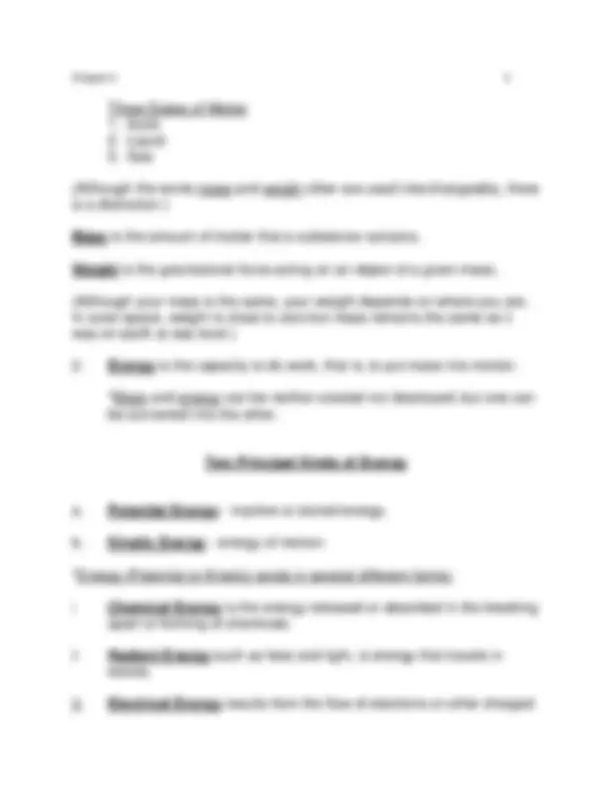
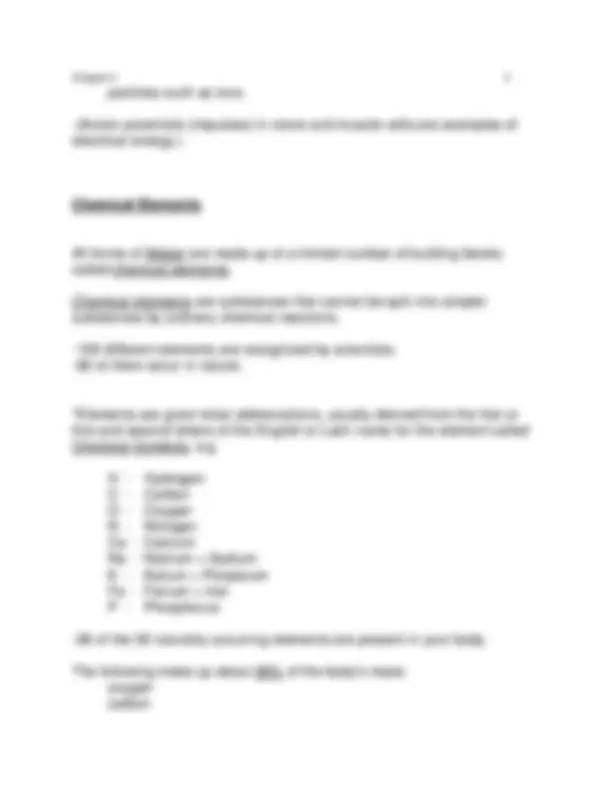
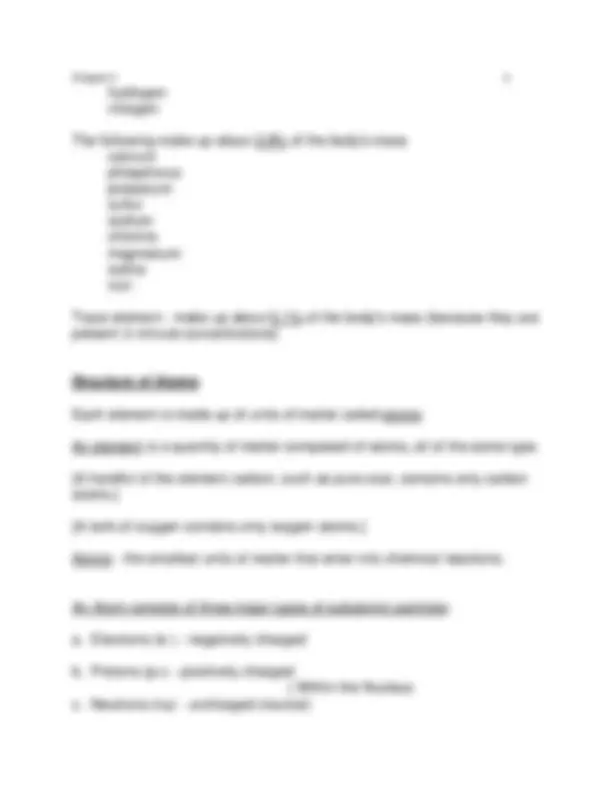
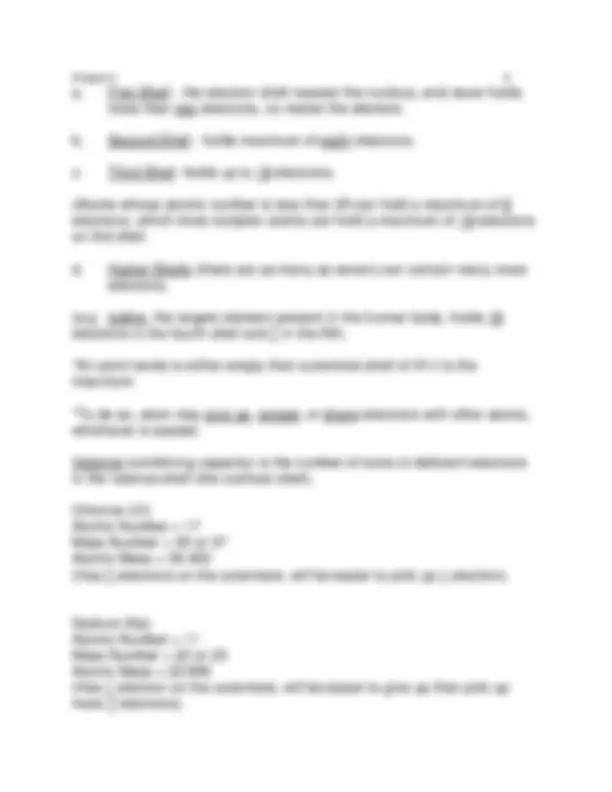
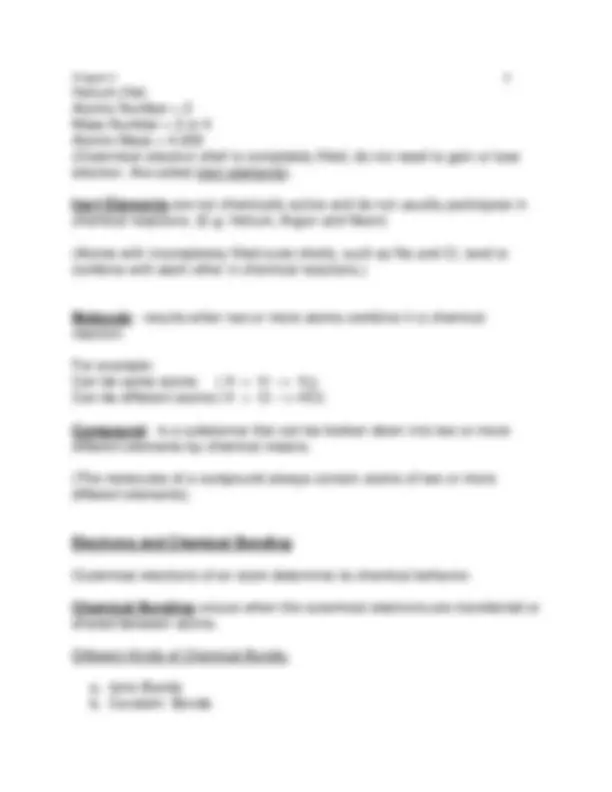
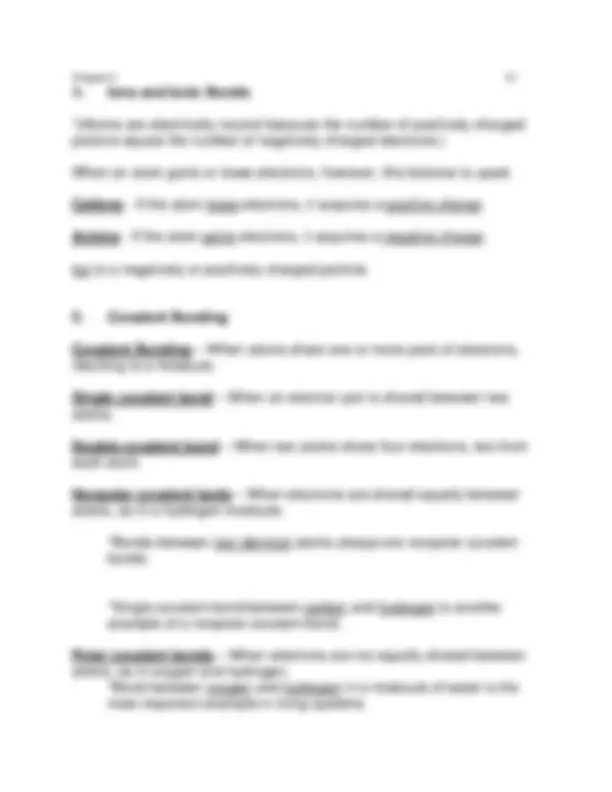
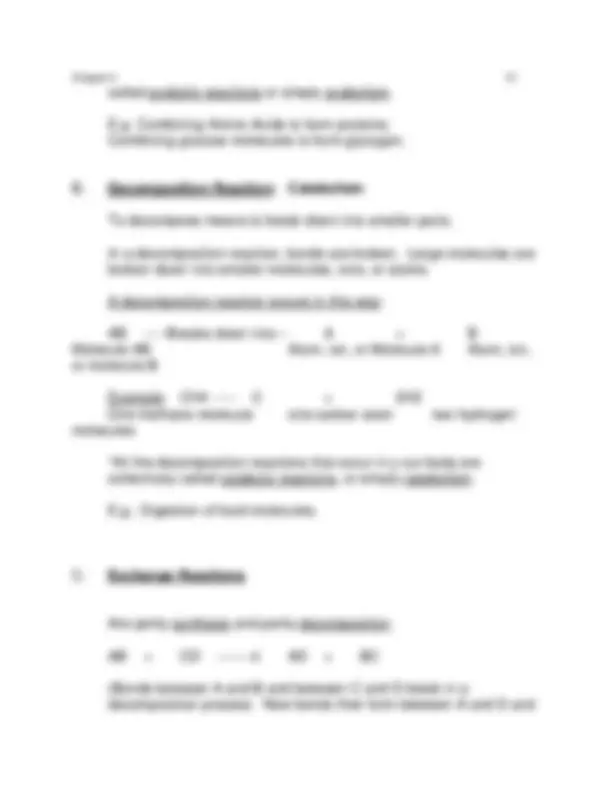
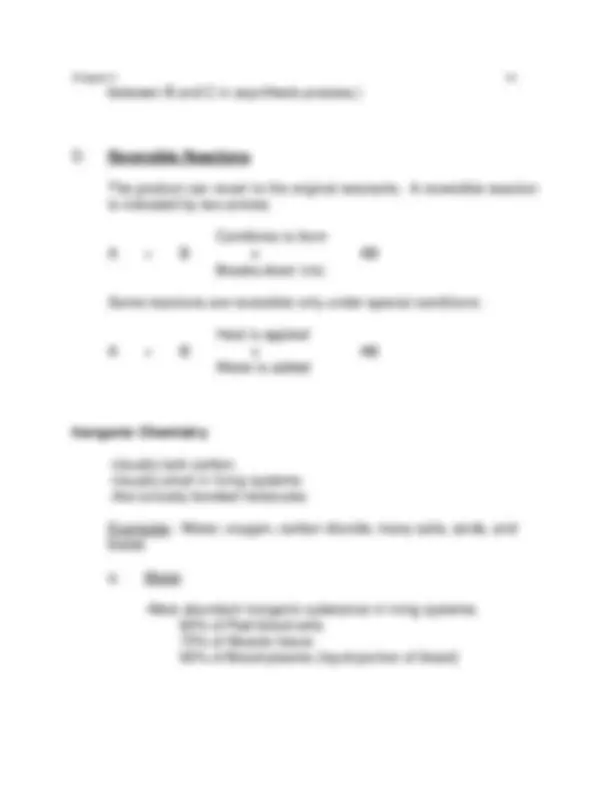
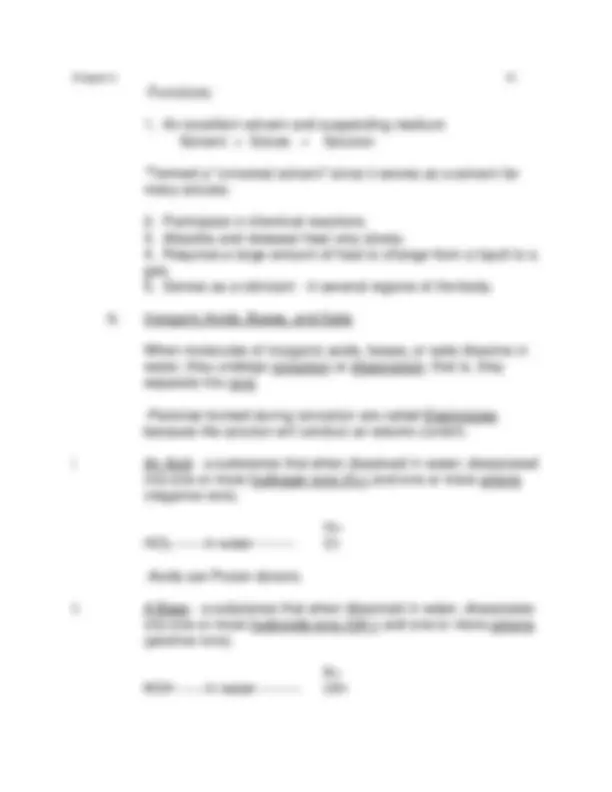
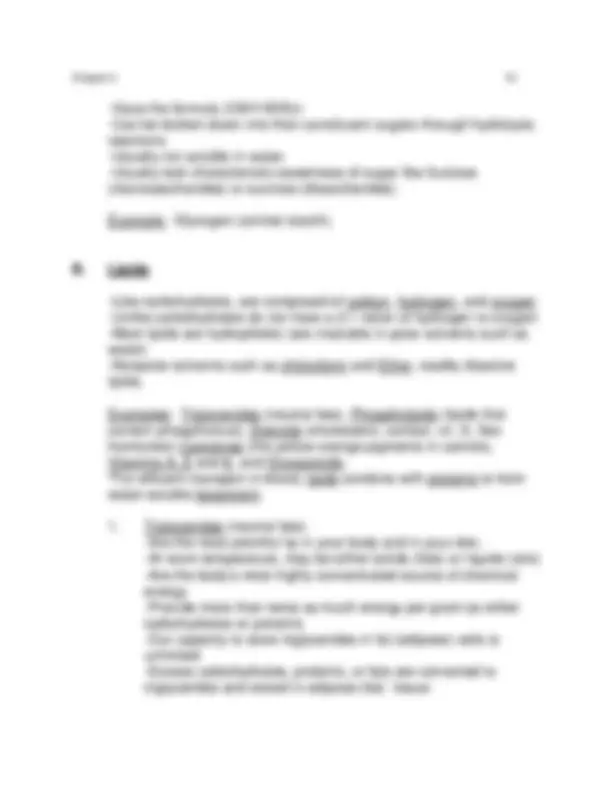
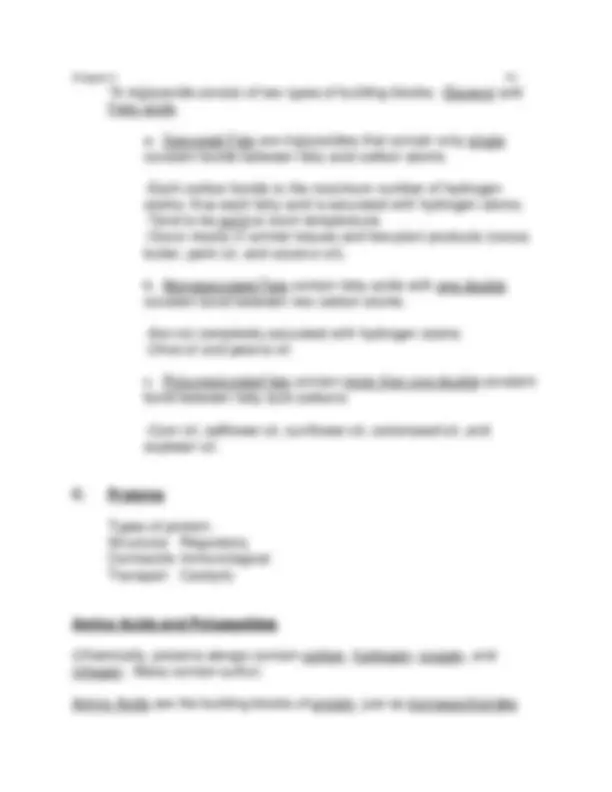
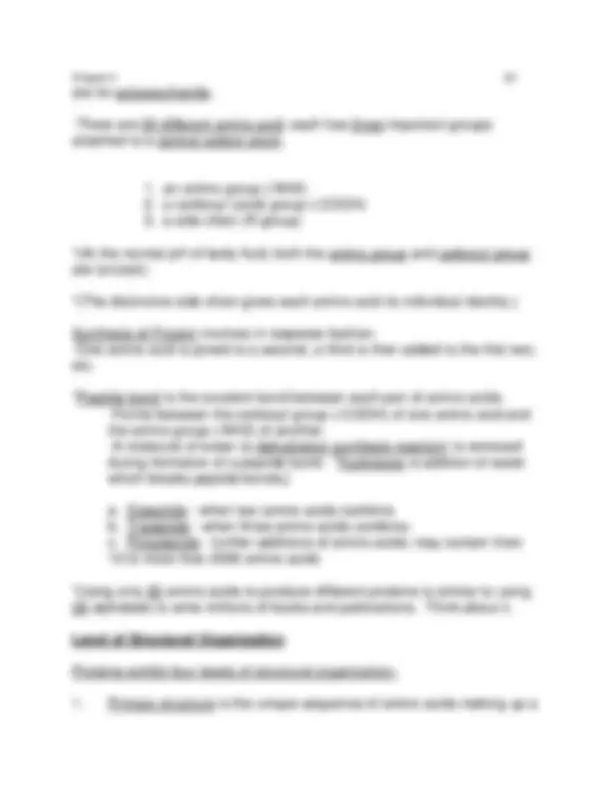
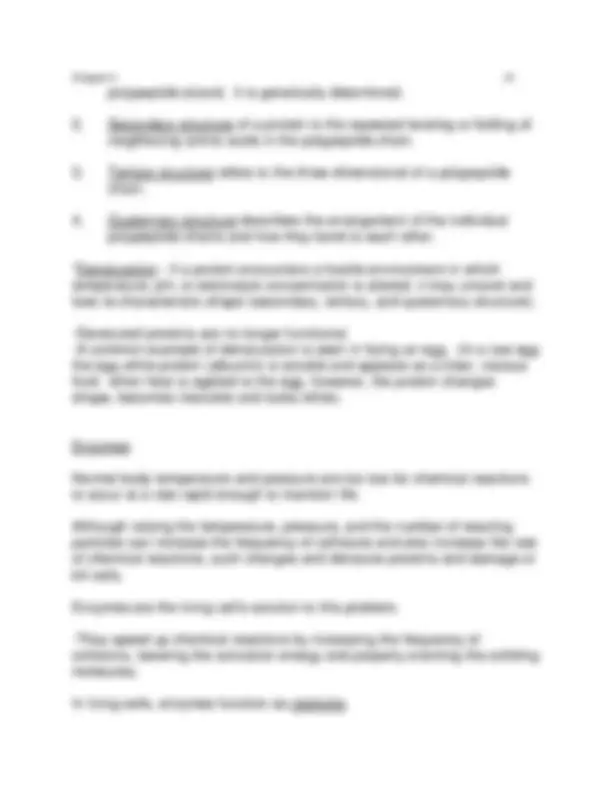
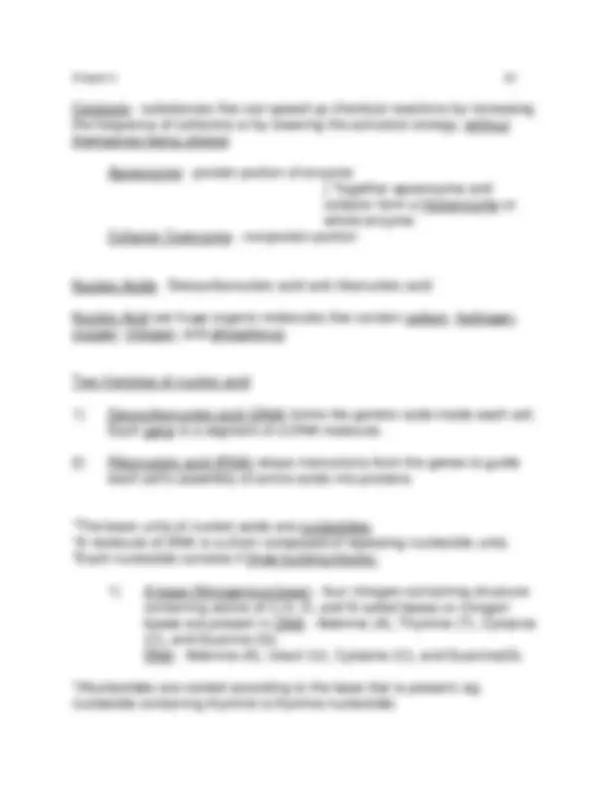
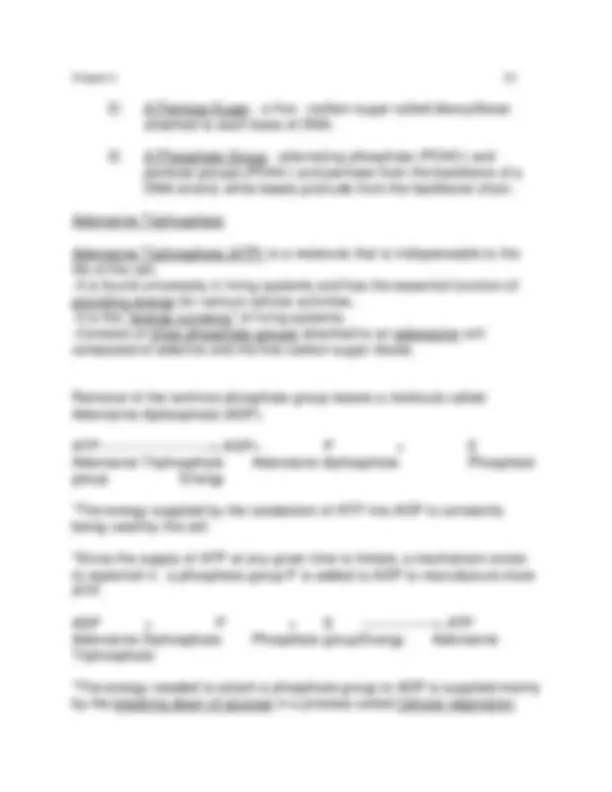
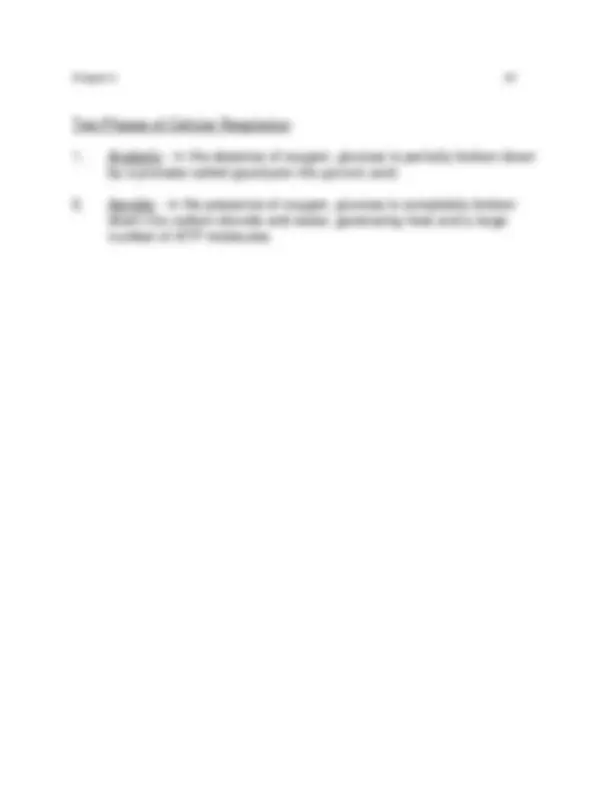


Study with the several resources on Docsity

Earn points by helping other students or get them with a premium plan


Prepare for your exams
Study with the several resources on Docsity

Earn points to download
Earn points by helping other students or get them with a premium plan
Community
Ask the community for help and clear up your study doubts
Discover the best universities in your country according to Docsity users
Free resources
Download our free guides on studying techniques, anxiety management strategies, and thesis advice from Docsity tutors
Chapter 2 Marieb Human Anatomy and Physiology Material Type: Notes; Professor: Gunn; Class: Anatomy and Physiology; Subject: Biology; University: University of Texas - Pan American;
Typology: Study notes
1 / 24

This page cannot be seen from the preview
Don't miss anything!

















Anatomy and Physiology Lecture
All living and nonliving things consist of matter.
particles such as ions.
-(Action potentials (impulses) in nerve and muscle cells are examples of electrical energy.)
Chemical Elements
All forms of Matter are made up of a limited number of building blocks called chemical elements.
Chemical elements are substances that cannot be split into simpler substances by ordinary chemical reactions.
-109 different elements are recognized by scientists; -92 of them occur in nature.
*Elements are given letter abbreviations, usually derived from the first or first and second letters of the English or Latin name for the element called Chemical Symbols, e.g.
H - Hydrogen C - Carbon O - Oxygen N - Nitrogen Ca - Calcium Na - Natrium = Sodium K - Kalium = Potassium Fe - Ferrum = Iron P - Phosphorus
-26 of the 92 naturally occurring elements are present in your body.
The following make up about 96% of the body's mass: oxygen carbon
hydrogen nitrogen
The following make up about 3.9% of the body's mass calcium phosphorus potassium sulfur sodium chlorine magnesium iodine iron
Trace element - make up about 0.1% of the body's mass (because they are present in minute concentrations)
Structure of Atoms
Each element is made up of units of matter called atoms.
An element is a quantity of matter composed of atoms, all of the same type.
[A handful of the element carbon, such as pure coal, contains only carbon atoms.]
[A tank of oxygen contains only oxygen atoms.]
Atoms - the smallest units of matter that enter into chemical reactions.
An Atom consists of three major types of subatomic particles:
a. Electrons (e-) - negatively charged
b. Protons (p+) - positively charged } Within the Nucleus c. Neutrons (n≅) - uncharged (neutral)
*Atoms of one electron, however, although chemically alike, may have different mass number because they have different number of neutrons.
Isotopes - Different atoms of an element that have the same number of protons (atomic number) but different number of neutron, thereby having different Mass number.
-All isotopes of an element have the same chemical properties because they have the same number of electrons.
Eg: Isotopes of oxygen are 16O, 17O, and 18O (or 0-16), 0-17, and 0-18). The numbers indicate the mass number (total number of Protons and Neutrons) in each Isotope.
Radioactive Isotopes (Radioisotopes) - Are unstable isotopes; their nuclear structure decays or changes to a more stable configuration.
-In decaying they emit radiation. (alpha or beta particular or gamma rays.)
Half-life is the time required for the radioactive isotope to emit half of the original amount of radiation.
Electrons and Chemical Reactions
Chemical reaction occurs when atoms combine with or break apart from other atoms.
-In the process, new products with different chemical properties are formed.
Electron interactions are the basis of all chemical reaction.
-Electron, in their motion around the nucleus, tend to spend most of the time in specific atomic regions, which are represented as circles lying at varying distances from the nucleus.
Electron shell is represented by each circle, which can hold a certain maximum of electrons.
a. First Shell - the electron shell nearest the nucleus, and never holds more than two electrons, no matter the element.
b. Second Shell - holds maximum of eight electrons.
c. Third Shell -holds up to 18 electrons.
(Atoms whose atomic number is less than 20 can hold a maximum of 8 electrons, which more complex atoms can hold a maximum of 18 electrons on 3rd shell.
d. Higher Shells (there are as many as seven) can contain many more electrons.
(e.g. Iodine, the largest element present in the human body, holds 18 electrons in the fourth shell and 7 in the fifth.
*An atom tends to either empty their outermost shell of fill it to the maximum.
*To do so, atom may give up, accept, or share electrons with other atoms, whichever is easiest.
Valence (combining capacity) is the number of extra or deficient electrons in the valence shell (the outmost shell).
Chlorine (Cl) Atomic Number = 17 Mass Number = 35 or 37 Atomic Mass = 35. (Has 7 electrons on the outermost, will be easier to pick up 1 electron).
Sodium (Na) Atomic Number = 11 Mass Number = 22 or 23 Atomic Mass = 22. (Has 1 electron on the outermost, will be easier to give up than pick up more 7 electrons).
A. Ions and Ionic Bonds
*(Atoms are electrically neutral because the number of positively charged protons equals the number of negatively charged electrons.)
When an atom gains or loses electrons, however, this balance is upset.
Cations - If the atom loses electrons, it acquires a positive charge.
Anions - If the atom gains electrons, it acquires a negative charge.
Ion is a negatively or positively charged particle.
B. Covalent Bonding
Covalent Bonding – When atoms share one or more pairs of electrons, resulting to a molecule.
Single covalent bond – When an electron pair is shared between two atoms.
Double covalent bond – When two atoms share four electrons, two from each atom.
Nonpolar covalent bods – When electrons are shared equally between atoms, as in a hydrogen molecule.
*Bonds between two identical atoms always are nonpolar covalent bonds.
*Single covalent bond between carbon and hydrogen is another example of a nonpolar covalent bond.
Polar covalent bonds – When electrons are not equally shared between atoms, as in oxygen and hydrogen. *Bond between oxygen and hydrogen in a molecule of water is the most important example in living systems.
(Partial negative charge (∗-) indicates that atom that attracts electrons more strongly.)
(Partial positive charge (∗+) indicates the atom that does not attract electrons strongly.)
*Polar covalent bonds allow water to dissolve many molecules that are important to life.
Intermolecular Forces
Intermolecular forces result from the weak electrostatic attraction between the oppositely charged parts of molecules, or between ions and molecules.
Hydrogen Bonds
Provides temporary bonding between certain atoms within large complex molecules such as proteins and nucleic acids.
Hydrogen bond consists of a hydrogen atom covalently bonded to one oxygen atom or nitrogen atom but attracted to another oxygen or nitrogen atom.
*(Because hydrogen bonds are weak, only about 5% as strong as covalent bonds, they do not bind atoms into molecules.)
*(However, they do serve as bridges between different molecules or between various parts of the same molecule.)
Example: Between water molecules Between various parts of the same molecules
called anabolic reactions or simply anabolism.
E.g. Combining Amino Acids to form proteins; Combining glucose molecules to form glycogen.
B. Decomposition Reaction: Catabolism
To decompose means to break down into smaller parts.
In a decomposition reaction, bonds are broken. Large molecules are broken down into smaller molecules, ions, or atoms.
A decomposition reaction occurs in this way:
AB -----Breaks down into--- A + B Molecule AB Atom, ion, or Molecule A Atom, ion, or molecule B
Example: CH4 ----- C + 2H One methane molecule one carbon atom two hydrogen molecules
*All the decomposition reactions that occur in y our body are collectively called catabolic reactions, or simply catabolism.
E.g.- Digestion of food molecules.
C. Exchange Reactions
Are partly synthesis and partly decomposition.
(Bonds between A and B and between C and D break in a decomposition process. New bonds then form between A and D and
between B and C in asynthesis process.)
D. Reversible Reactions
The product can revert to the original reactants. A reversible reaction is indicated by two arrows.
Combines to form A + B ≡ AB Breaks down into
Some reactions are reversible only under special conditions:
Heat is applied A + B ≡ AB Water is added
Inorganic Chemistry
-Usually lack carbon. -Usually small in living systems -Are ionically bonded molecules
Examples: Water, oxygen, carbon dioxide, many salts, acids, and bases
a. Water
-Most abundant inorganic substance in living systems. 60% of Red blood cells 75% of Muscle tissue 92% of Blood plasma (liquid portion of blood)
-Bases are Proton acceptors. iii A Salt - a substance that when dissolve din water, dissociates into cations and anions, neither of which is H+ or OH-
K+ KCl ----in water------------ Cl-
*Acids and Bases react with one another to form Salts.
HCl + KOH -------- KCl + H2O Acid Base Salt Water
Acid-Base Balance: The Concept of pH
Body fluids must maintain a fairly constant balance of acids and bases.
*pH is used to describe the degree of Acidity or Alkalinity (basicity) of a solution.
Exhibit 2.2 pg. 40
Increasing Acidity 7 -------------------------------------- 9 Neutrality pH Scale 0 1 2 3 4 5 6 7 8 9 10 11 12 13 14 8 Increasing Alkalinity (basicity)
Organic Chemistry
Χ Usually have carbon Χ Usually have hydrogen > Most frequently found elements Χ Usually have oxygen Χ Usually have nitrogen
Χ Usually have sulfur > Less frequently found
Χ Usually have Phosphorus
Χ Are Covalently bounded molecules
Examples: Carbohydrates, lipids, proteins, nucleic acids, and adenosine triphosphate (ATP).
A. Carbohydrates
Composed of carbon, hydrogen, and oxygen. Have 2:1 ration of hydrogen to oxygen.
Also known as sugars and starches. -Provide most of the energy needed for life.
Can be divided into three major groups on the bases of size.
i Monosaccharides (simple sugars) are compound containing from three to seven carbon atoms; e.g. Ribose (C5H10O5); glucose (C6H12O6); Fructose (C6H12)6),etc.
ii Disaccharides are also sugars, and consist of two monosaccharides joined chemically.
C6H12)6 + C6H12O6 ---> C12H22O11 + H2O Glucose Fructose Sucrose Water (Monosaccharide) (Monosaccharide) (Disaccharide)
Dehydration Synthesis is a process of disaccharide formation (combination of two monosaccharides) in which water is lost.
Digestion (hydrolysis) is a process by breaking down disaccharides into smaller molecules by adding water.
iii Polysaccharide consist of several monosaccharides joined together through dehydration synthesis.
*A triglyceride consist of two types of building blocks: Glycerol and Fatty acids
a. Saturated Fats are triglycerides that contain only single covalent bonds between fatty acid carbon atoms.
-Each carbon bonds to the maximum number of hydrogen atoms; thus each fatty acid is saturated with hydrogen atoms. -Tend to be solid at room temperature. -Occur mostly in animal tissues and few plant products (cocoa butter, palm oil, and coconut oil).
b. Monosaturated Fats contain fatty acids with one double covalent bond between two carbon atoms.
-Are not completely saturated with hydrogen atoms -Olive oil and peanut oil
c. Polyunsaturated fats contain more than one double covalent bond between fatty acid carbons.
-Corn oil, safflower oil, sunflower oil, cottonseed oil, and soybean oil.
C. Proteins
Types of protein: Structural Regulatory Contractile Immunological Transport Catalytic
Amino Acids and Polypeptides
(Chemically, proteins always contain carbon, hydrogen, oxygen, and nitrogen. Many contain sulfur)
Amino Acids are the building blocks of protein, just as monosaccharides
are for polysaccharide.
-There are 20 different amino acid; each has three important groups attached to a central carbon atom.
*(At the normal pH of body fluid, both the amino group and carboxyl group are ionized.)
*(The distinctive side chain gives each amino acid its individual identity.)
Synthesis of Protein involves in stepwise fashion: -One amino acid is joined to a second, a third is then added to the first two; etc.
*Peptide bond is the covalent bond between each pair of amino acids. -Forms between the carboxyl group (-COOH) of one amino acid and the amino group (-NH2) of another. -A molecule of water (a dehydration synthesis reaction) is removed during formation of a peptide bond: *[hydrolysis is addition of water which breaks peptide bonds.]
a. Dipeptide - when two amino acids combine b. Tripeptide - when three amino acids combine; c. Polypeptide - further additions of amino acids; may contain from 10 to more than 2000 amino acids
*Using only 20 amino acids to produce different proteins is similar to using 26 alphabets to write millions of books and publications. Think about it.
Level of Structural Organization
Proteins exhibit four levels of structural organization: